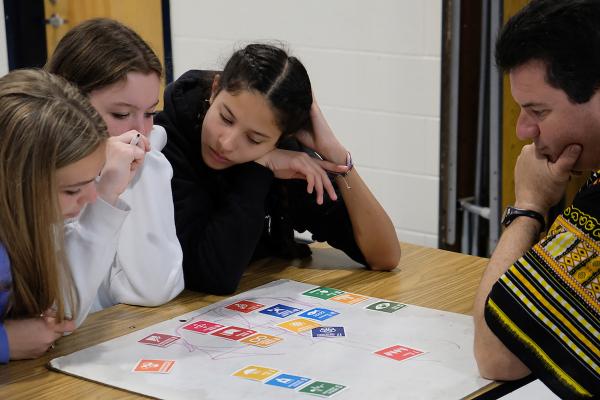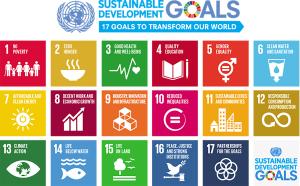Activity: Introducing the Sustainable Development Goals
We’re sharing activities for educators from the “Learning Locally, Transforming Globally” guide, coming Summer 2023. In this guide, you’ll find a step-by-step process for engaging learners in exploring the UN’s Sustainable Development Goals in their community, beginning with inquiry and leading to local action.
Sign up to be notified when the Learning Locally, Transforming Globally guide is available.
Tackling complex global issues like climate change, poverty, food insecurity, and racial inequities can be overwhelming for young people. Where do you start? One way to begin is by focusing on some of the UN’s 17 Sustainable Development Goals.
What are the UN’s Sustainable Development Goals (SDGs)? In 2015, the United Nations established 17 SDGs as "a universal call to action to end poverty, protect the planet, and ensure that all people enjoy peace and prosperity." The SDGs provide a blueprint toward sustainability by setting targets for economic, social, and ecological systems improvement with a deadline of 2030. These goals have been universally adopted by every country around the globe and measure our collective progress against the world’s most pressing challenges.
The Global Goals provide a powerful frame for helping students understand how their local actions can have a global impact. We use the SDGs as part of the framework in our forthcoming guide, “Learning Locally, Transforming Globally,” which engages learners in making change and taking action on a local or regional level and helps them develop the sense of agency that they will need to tackle the challenges we face as a global community.
Here are two activities to introduce the SDGs to your students as they work to define who and what contributes to a safe and healthy life for all.
Activity: Define Quality of Life
What does your community need for every living thing to have a safe and healthy life? Students will develop a definition of “quality of life” for their own community.
- Open with a visualization activity. Ask learners to imagine themselves living in an ideal future, where every community resident and living thing has what they need to live a safe and healthy life. Give learners some time to picture what this future life might look like.
- After completing the visualization, pose the question: What does our community need for every living thing to have a safe and healthy life? To prompt discussion, share some broad features of a good quality of life, such as a secure home and surroundings, a secure family, good health, and a healthy environment.
- Break out in small groups and have learners brainstorm and record 5–7 quality-of-life features.
- Invite groups to share their lists and compile responses in a master quality-of-life features list that learners can refer to on chart paper, sticky notes, or whiteboards. (In a digital setting, quality-of-life features can be shared in a chat or recorded on a Jamboard, Google Slide, or Google Doc.) Together, notice any elements that appear more than once. Record any missing features.
- As groups share their quality-of-life features lists, invite curiosity about what is different among the lists. What contributes to these different perspectives? How might these lists look different from the perspective of different community members? What is our responsibility to create the conditions for all living things, human and non-human alike, to be healthy and safe?
Activity: Introduce and Prioritize the SDGs
Students reflect on quality of life, then expand their thinking more broadly to the globe and their community.
To prepare for this activity, make copies of the Sustainable Development Goals poster (download ZIP file), one for each student group. We recommend printing on an 11x17 sheet of paper. Next, cut out each goal on individual cards. (This activity can also be done virtually using a copy of this Jamboard template.)
- Play one (or more) of these videos to introduce your students to the global goals: "Sustainable Development Goals: Improve Life All Around The Globe" (video) or "The World's Largest Lesson | Global Goals" (video)
- After viewing one of these videos, invite learners to discuss what they saw, heard, and think.
- Now, learners will engage with the SDGs and sort them based on personal, community, and global significance. To begin, select a few of the SDGs at random and discuss them: What is this goal about? What does it mean? What features of a community would connect to this goal? How would a community know if they are meeting this goal? Ask learners to consider which goals are personally significant to them. Why? Which goals are most significant for the local community? For the world?
- Working in small groups or individually, have learners sort and prioritize the SDGs in three categories: by self, community, and world. Ask them to discuss, What goals would you prioritize to help you achieve your vision of an ideal future?
These activities were adapted from the forthcoming publication, “Learning Locally, Transforming Globally.” Sign up to be notified when the guide is available.



